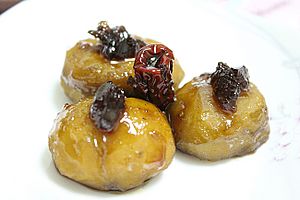Suksil-gwa facts for kids
 |
|
| Type | Hangwa |
|---|---|
| Place of origin | Korea |
| Associated national cuisine | Korean cuisine |
| Main ingredients | Chestnuts, jujube, ginger |
| Ingredients generally used | Honey, cinnamon powder, pine nuts |
| Korean name | |
| Hangul |
숙실과
|
|---|---|
| Hanja |
熟實果
|
| Revised Romanization | suksil-gwa |
| McCune–Reischauer | suksil-kwa |
| IPA | [suk̚.ɕ͈il.ɡwa] |
Suksil-gwa (숙실과; 熟實果) is a special Korean sweet treat. Its name means "cooked fruit." It is a type of hangwa, which is a traditional Korean confection.
This delicious snack is made from cooked fruits, roots, or seeds. These ingredients are sweetened with honey. Some common ingredients used are chestnuts, jujubes, and ginger.
Suksil-gwa was mostly made for important events. These included big parties called janchi and special family ceremonies called jesa (ancestral rites). A long time ago, during the Joseon Dynasty (1392–1897), important people called yangban (scholar-officials) and the royal family enjoyed it. This was because it needed good quality fruit and a lot of careful cooking. Suksil-gwa is usually served with two or three different kinds on one plate.
Different Kinds of Suksil-gwa
Suksil-gwa can be made in two main ways: ran-type and cho-type. The way it's cooked changes how it looks and feels.
Ran-type Suksil-gwa
The ran-type involves mashing the cooked ingredients. Then, they are mixed with honey and shaped into the form of the original fruit.
- Yullan (율란) is shaped like a chestnut. It's made by mashing boiled chestnuts. This mash is mixed with cinnamon powder and honey. The mixture is then shaped like small chestnuts. It's often topped with pine nut powder.
- Joran (조란) looks like a jujube. It's made by mashing boiled jujubes after removing their seeds. This mashed jujube is mixed with cinnamon powder and honey. It's then shaped into small jujubes. Sometimes, it can even have a chestnut and honey filling inside!
- Saengnan (생란) is shaped like ginger. It's also called gangnan (강란) or saenggang-ran (생강란). To make it, ginger is boiled to make it less spicy. Then, it's simmered in honey. Once cooled, it's shaped like ginger pieces and topped with pine nut powder.
Cho-type Suksil-gwa
The cho-type is made without mashing the ingredients. They are cooked whole or in pieces.
- Bamcho (밤초) is also known as yulcho (율초). This treat uses whole peeled chestnuts. The chestnuts are simmered in water with honey. When the honey soaks into the chestnuts, cinnamon powder is added. Then, they are drained and coated with pine nut powder. Both fresh and dried chestnuts can be used.
- Daechu-cho (대추초) is made from jujubes. The seeds are removed from the jujubes. Then, they are lightly steamed and stuffed with a few pine nuts. These stuffed jujubes are simmered with honey and cinnamon powder. Finally, they are coated with pine nut powder. When served, a toasted pine nut is often placed on the end of the jujube.
See also
 In Spanish: Suksilgwa para niños
In Spanish: Suksilgwa para niños

